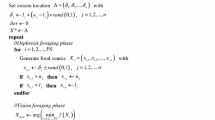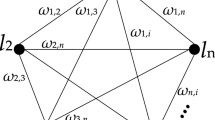Abstract
As a newly proposed algorithm, fruit fly optimization algorithm (FOA) has been shown to have a strong capacity for solving numerical optimization problems. However, the basic FOA is faced with the challenges of poor diversity of the swarm and weak local search ability because of the improper osphresis operation and vision operation. To overcome these limitations synthetically, we propose an improved FOA based on hybrid location information exchange mechanism (HFOA) aiming at improving the swarm diversity in a more efficient way and well balance the global search and local search abilities. First, the proposed HFOA enables flies to communicate with each other and conduct local search in a swarm based approach. Second, osphresis operation is conducted in probability to balance the global search and local search processes. Finally, a mutation strategy called cataclysm policy is designed to help the flies jump out of the local extreme points. 18 complex continuous benchmark functions are used to test the performance of HFOA. Numerical experiments results indicate that HFOA outperforms main state-of-the-art algorithms. A classical non-deterministic polynomial hard problem—a widely-researched joint replenishment and delivery scheduling problem with resource restrictions is also used to further verify the ability of HFOA in solving practical operation management problems. Results show that HFOA can obtain lower operation cost than other widely used methods, demonstrating its ability to solve various complex optimization problems.
Similar content being viewed by others
References
Beezão AC, Cordeau JF, Laporte G, Yanasse HH (2017) Scheduling identical parallel machines with tooling constraints. Eur J Oper Res 257(3):834–844
Bandaru S, Ng AHC, Deb K (2017) Data mining methods for knowledge discovery in multi-objective optimization: Part A – Survey. Expert Systems Appl 70:139–159
Bhuvana J, Aravindan C (2016) Memetic algorithm with preferential local search using adaptive weights for multi-objective optimization problems. Soft Comput 20(4):1365–1388
Cha BC, Moon IK, Park JH (2008) The joint replenishment and delivery scheduling of the one-warehouse, n-retailer system. Transp Res Part E: Logist Transp Rev 44(5):720–730
Chen PW, Lin WY, Huang TH, Pan WT (2013) Using fruit fly optimization algorithm optimized grey model neural network to perform satisfaction analysis for e-business service. Appl Math Inf Sci 7(2L):459–465
Civicioglu P (2013) Backtracking search optimization algorithm for numerical optimization problems. Appl Math Comput 219(15):8121–8144
Cui L, Li G, Lin Q, Chen J, Lu N (2016) Adaptive differential evolution algorithm with novel mutation strategies in multiple sub-populations. Comput Oper Res 67:155–173
Chan CK, Li LY, Ng CT, Cheung BK, Langevin A (2006) Scheduling of multi-buyer joint replenishments. Int J Product Econ 102(1):132–142
Chau KW, Wu CL (2010) A hybrid model coupled with singular spectrum analysis for daily rainfall prediction. J Hydroinf 12(4):458–473
Gajjar S, Sarkar M, Dasgupta K (2016) FAMACROW: Fuzzy and ant colony optimization based combined mac, routing, and unequal clustering cross-layer protocol for wireless sensor networks. Appl Soft Comput 43:235–247
Ghareb AS, Bakar AA, Hamdan AR (2016) Hybrid feature selection based on enhanced genetic algorithm for text categorization’. Expert Systems Appl 49:31–47
Goyal SK, Satir AT (1989) Joint replenishment inventory control: deterministic and stochastic models. Eur J Oper Res 38(1):2–13
Glover F (1989) Tabu search—Part I. Informs J Comput 1(1):89–98
Garg H (2016) A hybrid PSO-GA algorithm for constrained optimization problems. Appl Math Comput 274(11):292–305
He Z, Qi H, Yao Y, Ruan L (2014) Inverse estimation of the particle size distribution using the fruit fly optimization algorithm. Appl Therm Eng 88:306–314
Hong SP, Kim YH (2009) A genetic algorithm for joint replenishment based on the exact inventory cost. Computers Operations Research 36(1):167–175
Holland J (1994) Adaptation in natural and artificial systems: an introductory analysis with applications to biology, control and artificial intelligence. Q Rev Biol 69(1):126–137
Kennedy J, Eberhart R (2011) Particle swarm optimization. Springer US
Kirkpatrick S, Gelatt CD, Vecchi MP (1983) Optimization by simulated annealing. Science 220(4598):671–680
Khouja M, Goyal S (2008) A review of the joint replenishment problem literature: 1989–2005. Eur J Oper Res 186(1):1–16
Khouja M, Michalewicz Z, Satoskar SS (2000) A comparison between genetic algorithms and the RAND method for solving the joint replenishment problem. Prod Plan Control 11(6):556–564
Li H, Guo S, Zhao H, Su C, Wang, B (2012) Annual electric load forecasting by a least squares support vector machine with a fruit fly optimization algorithm. Energies 5(11): 4430–4445
Lin SM (2013) Analysis of service satisfaction in web auction logistics service using a combination of fruit fly optimization algorithm and general regression neural network. Neural Comput Applic 22(3–4):783–791
Moon IK, Cha BC (2006) The joint replenishment problem with resource restriction. Eur J Oper Res 173(1):190–198
Mitić M, Vuković N, Petrović M, Miljković Z (2015) Chaotic fruit fly optimization algorithm. Knowl-Based Syst 89:446–458
Niu J, Zhong W, Liang Y, Luo N, Qian F (2015) Fruit fly optimization algorithm based on differential evolution and its application on gasification process operation optimization. Knowl-Based Syst 88:253–263
Pan WT (2012) A new fruit fly optimization algorithm: taking the financial distress model as an example. Knowl-Based Syst 26:69–74
Pan QK, Sang HY, Duan JH, Gao L (2014) An improved fruit fly optimization algorithm for continuous function optimization problems. Knowl-Based Syst 62:69–83
Pan WT (2013) Using modified fruit fly optimisation algorithm to perform the function test and case studies. Connection. Science 25(2–3):151–160
Qu H, Wang L, Liu R (2015) A contrastive study of the stochastic location-inventory problem with joint replenishment and independent replenishment. Expert Systems Appl 42(4):2061–2072
Rahman MM, Islam MM, Murase K, Yao X (2015) Layered ensemble architecture for time series forecasting. IEEE Transactions on Cybernetics 46(1):270–283
Shan D, Cao GH, Dong HJ (2013) LGMS-FOA: an improved fruit fly optimization algorithm for solving optimization problems. Mathematical Problems in Engineering 2013(7): 1256–1271
Storn R, Price K (1997) Differential evolution–a simple and efficient heuristic for global optimization over continuous spaces. J Global Optim 11(4):341–359
Sheng W, Bao Y (2013) Fruit fly optimization algorithm based fractional order fuzzy-PID controller for electronic throttle. Nonlinear. Dynamics 73(1–2):611–619
Shu FT (1971) Economic ordering frequency for two items jointly replenished. Manage Sci 17(6):B406–B410
Sindhuchao S, Romeijn HE, Akçali E, Boondiskulchok R (2005) An integrated inventory-routing system for multi-item joint replenishment with limited vehicle capacity. J Global Optim 32(1):93–118
Taormina R, Chau KW (2015) Data-driven input variable selection for rainfall–runoff modeling using binary-coded particle swarm optimization and extreme learning machines. J Hydrol 529(3):1617–1632
Wang WC, Chau KW, Xu DM, Chen XY (2015) Improving forecasting accuracy of annual runoff time series using ARIMA based on EEMD decomposition. Water Resources. Management 29(8):2655–2675
Wu L, Zuo C, Zhang H (2015) A cloud model based fruit fly optimization algorithm. Knowl-Based Syst 89:603–617
Wu G, Mallipeddi R, Suganthan PN, Wang R, Chen H (2016) Differential evolution with multi-population based ensemble of mutation strategies. Inf Sci 329:329–345
Wu CL, Chau KW, Li YS (2009) Methods to improve neural network performance in daily flows prediction. J Hydrol 372(1–4):80–93
Wang L, Zheng XL, Wang SY (2013) A novel binary fruit fly optimization algorithm for solving the multidimensional knapsack problem. Knowl-Based Syst 48:17–23
Wang L, Shi Y, Liu S (2015) An improved fruit fly optimization algorithm and its application to joint replenishment problems. Expert Systems Appl 42(9):4310–4323
Wang L, Liu R, Liu S (2016) An effective and efficient fruit fly optimization algorithm with level probability policy and its applications. Knowl-Based Syst 97:158–674
Wang L, Dun CX, Lee CG, Fu QL, Zeng YR (2013) Model and algorithm for fuzzy joint replenishment and delivery scheduling without explicit membership function. Int J Adv Manuf Technol 66(9–12):1907–1920
Wang L, Dun CX, Bi WJ, Zeng YR (2012) An effective and efficient differential evolution algorithm for the integrated stochastic joint replenishment and delivery model. Knowl-Based Syst 36:104–114
Wang L, Liu R, Liu S (2017) Variable neighborhood search incorporating a new bounding procedure for joint replenishment and delivery problem. J Oper Res Soc. doi:10.1057/s41274-017-0188-5
Yan P, Wang G, Che A, Li YYR (2016) Hybrid discrete differential evolution algorithm for biobjective cyclic hoist scheduling with reentrance. Comput Oper Res 76:155–166
Yuan X, Dai X, Zhao J, He Q (2014) On a novel multi-swarm fruit fly optimization algorithm and its application. Appl Math Comput 233(3):260–271
Zeng YR, Peng L, Zhang J, Wang L (2016) An effective hybrid differential evolution algorithm incorporating simulated annealing for joint replenishment and delivery problem with trade credit. Int J Comput Intell Syst 9(6):1001–1015
Zeng YR, Zeng Y, Choi BJ, Wang L (2017) Multifactor-influenced energy consumption forecasting using enhanced back-propagation neural network. Energy 127:381–396
Zhang SW, Chau KW (2009) Dimension reduction using semi-supervised locally linear embedding for plant leaf classification. Lect Notes Comput Sci 5754:948–955
Zhang J, Chau KW (2009) Multilayer ensemble pruning via novel multi-sub-swarm particle swarm optimization. J Universal Comput Sci 15(4):840–858
Zheng XL, Wang L, Wang SY (2014) A novel fruit fly optimization algorithm for the semiconductor final testing scheduling problem. Knowl-Based Syst 57:95–103
Zhang Y, Cui G, Wu J, Pan WT, He Q (2016) A novel multi-scale cooperative mutation fruit fly optimization algorithm. Knowl-Based Syst 114:24–35
Acknowledgements
This research is partially supported by National Natural Science Foundation of China (Nos: 71371080; 71531009), and Humanities and Social Sciences Foundation of Chinese Ministry of Education (No. 15YJA630095).
Author information
Authors and Affiliations
Corresponding author
Rights and permissions
About this article
Cite this article
Lv, SX., Zeng, YR. & Wang, L. An effective fruit fly optimization algorithm with hybrid information exchange and its applications. Int. J. Mach. Learn. & Cyber. 9, 1623–1648 (2018). https://doi.org/10.1007/s13042-017-0669-5
Received:
Accepted:
Published:
Issue Date:
DOI: https://doi.org/10.1007/s13042-017-0669-5















